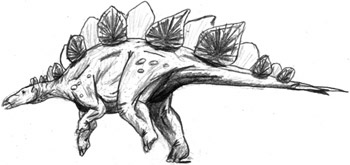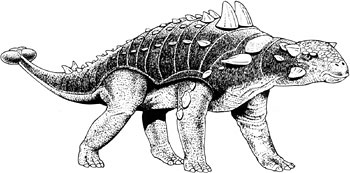
Stegosaurus
Thyreophora, the armored dinosaurs
 Stegosaurus |
The Thyreophora are a group of small to quite large armored plant-eating dinosaurs. The most familiar are Stegosaurus and Ankylosaurus, though there were many others. Ornithopods are one of three major groups of Ornithischia, or "bird-hipped" dinosaurs.
The earliest Thyreophoran was Scutellosaurus, a slender-tailed beast known from the earliest Jurassic of western North America, and is among the earliest known Ornithischians. It is among the smallest of the armored dinosaurs, and grew to only one and one-half meters long. Like its kin, it had armor plates set into the skin of its back, though these were not as large as in later Thyreophorans.
The next known Thyreophoran is Scelidosaurus, which lived in western Europe a little over 180 million years ago. This dinosaur grew to about four meters long and a little over a meter tall, walking on all four legs. Like later
 Artist's reconstruction of Ankylosaurus. |
The remaining Thyreophorans consist of two major groups: the Stegosauria and the Ankylosauria. The stegosaurids had two rows of spikes or plates runnning along their backs and tails. They were most diverse in the late Jurassic, though the genus Dravidosaurus lived in southern India in the late Cretaceous, when the group went extinct. Stegosaurids are known from most of the globe.
The other group, the Ankylosauria, had more extensive armoring, and often
whole patches of external bone were fused into plates. Early in the
Cretaceous, most of these
belonged to the Nodosaurid subgroup (though one genus, Sarcolestes,
is known from the Jurassic). In the later Cretaceous, most are Ankylosaurids,
distinguished by their broad heads, spikes extending from the backs of their
skulls, and heavy club-like tails. It is generally believed that the club
could be used as a defensive weapon against predators.
Original page created by Brian Speer 5/1998; modifications since 2005 by David Smith. Stegosaurus drawing © Rob Gay.